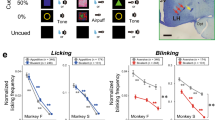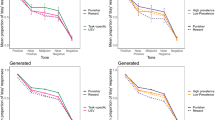Abstract
Natural environments are uncertain. Uncertainty of emotional outcomes can induce anxiety and raise vigilance, promote and signal the opportunity for learning, modulate economic choice and regulate risk-seeking. Here we demonstrate that a subset of neurons in the anterodorsal region of the primate septum (ADS) are primarily devoted to processing uncertainty in a highly specific manner. Those neurons were selectively activated by visual cues indicating probabilistic delivery of reward (for example, 25%, 50% and 75% reward) and did not respond to cues indicating certain outcomes (0% and 100% reward). The average ADS uncertainty response was graded with the magnitude of reward uncertainty and selectively signaled uncertainty about rewards rather than punishments. The selective and graded information about reward uncertainty encoded by many neurons in the ADS may underlie modulation of uncertainty of value- and sensorimotor-related areas to regulate goal-directed behavior.
This is a preview of subscription content, access via your institution
Access options
Subscribe to this journal
Receive 12 print issues and online access
$209.00 per year
only $17.42 per issue
Buy this article
- Purchase on Springer Link
- Instant access to full article PDF
Prices may be subject to local taxes which are calculated during checkout





Similar content being viewed by others
References
Hirsh, J.B., Mar, R.A. & Peterson, J.B. Psychological entropy: a framework for understanding uncertainty-related anxiety. Psychol. Rev. 119, 304–320 (2012).
Bach, D.R. & Dolan, R.J. Knowing how much you don't know: a neural organization of uncertainty estimates. Nat. Rev. Neurosci. 13, 572–586 (2012).
Behrens, T.E., Woolrich, M.W., Walton, M.E. & Rushworth, M.F. Learning the value of information in an uncertain world. Nat. Neurosci. 10, 1214–1221 (2007).
Platt, M.L. & Huettel, S.A. Risky business: the neuroeconomics of decision making under uncertainty. Nat. Neurosci. 11, 398–403 (2008).
Bromberg-Martin, E.S. & Hikosaka, O. Midbrain dopamine neurons signal preference for advance information about upcoming rewards. Neuron 63, 119–126 (2009).
Dayan, P., Kakade, S. & Montague, P.R. Learning and selective attention. Nat. Neurosci. 3 (suppl.), 1218–1223 (2000).
Pearce, J.M. & Hall, G. A model for Pavlovian learning: variations in the effectiveness of conditioned but not of unconditioned stimuli. Psychol. Rev. 87, 532–552 (1980).
Yu, A.J. & Dayan, P. Uncertainty, neuromodulation, and attention. Neuron 46, 681–692 (2005).
Schultz, W. et al. Explicit neural signals reflecting reward uncertainty. Phil. Trans. R. Soc. Lond. B 363, 3801–3811 (2008).
Tversky, A. & Kahneman, D. Judgment under Uncertainty: Heuristics and Biases. Science 185, 1124–1131 (1974).
Rushworth, M.F. & Behrens, T.E. Choice, uncertainty and value in prefrontal and cingulate cortex. Nat. Neurosci. 11, 389–397 (2008).
Preuschoff, K. & Bossaerts, P. Adding prediction risk to the theory of reward learning. Ann. NY Acad. Sci. 1104, 135–146 (2007).
Monosov, I.E. & Hikosaka, O. Regionally distinct processing of rewards and punishments by the primate ventromedial prefrontal cortex. J. Neurosci. 32, 10318–10330 (2012).
Fiorillo, C.D., Tobler, P.N. & Schultz, W. Discrete coding of reward probability and uncertainty by dopamine neurons. Science 299, 1898–1902 (2003).
McCoy, A.N. & Platt, M.L. Risk-sensitive neurons in macaque posterior cingulate cortex. Nat. Neurosci. 8, 1220–1227 (2005).
O'Neill, M. & Schultz, W. Coding of reward risk by orbitofrontal neurons is mostly distinct from coding of reward value. Neuron 68, 789–800 (2010).
Preuschoff, K., Quartz, S.R. & Bossaerts, P. Human insula activation reflects risk prediction errors as well as risk. J. Neurosci. 28, 2745–2752 (2008).
Christopoulos, G.I., Tobler, P.N., Bossaerts, P., Dolan, R.J. & Schultz, W. Neural correlates of value, risk, and risk aversion contributing to decision making under risk. J. Neurosci. 29, 12574–12583 (2009).
Preuschoff, K., Bossaerts, P. & Quartz, S.R. Neural differentiation of expected reward and risk in human subcortical structures. Neuron 51, 381–390 (2006).
Ogawa, M. et al. Risk-responsive orbitofrontal neurons track acquired salience. Neuron 77, 251–258 (2013).
Hsu, M., Bhatt, M., Adolphs, R., Tranel, D. & Camerer, C.F. Neural systems responding to degrees of uncertainty in human decision-making. Science 310, 1680–1683 (2005).
Risold, P.Y. & Swanson, L.W. Connections of the rat lateral septal complex. Brain Res. Brain Res. Rev. 24, 115–195 (1997).
Gray, J.A. & McNaughton, N. Comparison between the behavioural effects of septal and hippocampal lesions: a review. Neurosci. Biobehav. Rev. 7, 119–188 (1983).
Risold, P.Y. & Swanson, L.W. Chemoarchitecture of the rat lateral septal nucleus. Brain Res. Brain Res. Rev. 24, 91–113 (1997).
McNaughton, N. & Gray, J.A. Anxiolytic action on the behavioural inhibition system implies multiple types of arousal contribute to anxiety. J. Affect. Disord. 61, 161–176 (2000).
Menard, J. & Treit, D. Lateral and medial septal lesions reduce anxiety in the plus-maze and probe-burying tests. Physiol. Behav. 60, 845–853 (1996).
Nishijo, H. et al. Motivation-related neuronal activity in the object discrimination task in monkey septal nuclei. Hippocampus 7, 536–548 (1997).
Nishijo, H. et al. Septal neuronal responses related to spatial representation in monkeys. Hippocampus 7, 460–464 (1997).
Matsumoto, M. & Hikosaka, O. Representation of negative motivational value in the primate lateral habenula. Nat. Neurosci. 12, 77–84 (2009).
Shannon, C.E. A mathematical theory of communication. Bell Syst. Tech. J. 27, 379–423 (1948).
Esber, G.R. & Haselgrove, M. Reconciling the influence of predictiveness and uncertainty on stimulus salience: a model of attention in associative learning. Proc. Biol. Sci. 278, 2553–2561 (2011).
Anselme, P. The uncertainty processing theory of motivation. Behav. Brain Res. 208, 291–310 (2010).
Weber, E.U., Shafir, S. & Blais, A.R. Predicting risk sensitivity in humans and lower animals: risk as variance or coefficient of variation. Psychol. Rev. 111, 430–445 (2004).
Neuringer, A. Operant variability: evidence, functions, and theory. Psychon. Bull. Rev. 9, 672–705 (2002).
Sheehan, T.P., Chambers, R.A. & Russell, D.S. Regulation of affect by the lateral septum: implications for neuropsychiatry. Brain Res. Brain Res. Rev. 46, 71–117 (2004).
Powell, E.W. Limbic projections to the thalamus. Exp. Brain Res. 17, 394–401 (1973).
Vogt, B.A., Pandya, D.N. & Rosene, D.L. Cingulate cortex of the rhesus monkey: I. Cytoarchitecture and thalamic afferents. J. Comp. Neurol. 262, 256–270 (1987).
Cavada, C., Company, T., Tejedor, J., Cruz-Rizzolo, R.J. & Reinoso-Suarez, F. The anatomical connections of the macaque monkey orbitofrontal cortex. A review. Cereb. Cortex 10, 220–242 (2000).
Staiger, J.F. & Nurnberger, F. The efferent connections of the lateral septal nucleus in the guinea pig: intrinsic connectivity of the septum and projections to other telencephalic areas. Cell Tissue Res. 264, 415–426 (1991).
Swanson, L.W. & Cowan, W.M. The connections of the septal region in the rat. J. Comp. Neurol. 186, 621–655 (1979).
Vogt, B.A., Finch, D.M. & Olson, C.R. Functional heterogeneity in cingulate cortex: the anterior executive and posterior evaluative regions. Cereb. Cortex 2, 435–443 (1992).
Padoa-Schioppa, C. & Assad, J.A. Neurons in the orbitofrontal cortex encode economic value. Nature 441, 223–226 (2006).
Tsuchida, A., Doll, B.B. & Fellows, L.K. Beyond reversal: a critical role for human orbitofrontal cortex in flexible learning from probabilistic feedback. J. Neurosci. 30, 16868–16875 (2010).
Walton, M.E., Behrens, T.E., Noonan, M.P. & Rushworth, M.F. Giving credit where credit is due: orbitofrontal cortex and valuation in an uncertain world. Ann. NY Acad. Sci. 1239, 14–24 (2011).
Ressler, K.J. & Mayberg, H.S. Targeting abnormal neural circuits in mood and anxiety disorders: from the laboratory to the clinic. Nat. Neurosci. 10, 1116–1124 (2007).
Schmitz, A. & Grillon, C. Assessing fear and anxiety in humans using the threat of predictable and unpredictable aversive events (the NPU-threat test). Nat. Protoc. 7, 527–532 (2012).
Coates, J.M. & Herbert, J. Endogenous steroids and financial risk taking on a London trading floor. Proc. Natl. Acad. Sci. USA 105, 6167–6172 (2008).
Rosen, J.B. & Schulkin, J. From normal fear to pathological anxiety. Psychol. Rev. 105, 325–350 (1998).
Daye, P.M., Monosov, I.E., Hikosaka, O., Leopold, D.A. & Optican, L.M. pyElectrode: an open-source tool using structural MRI for electrode positioning and neuron mapping. J. Neurosci. Methods 213, 123–131 (2013).
Acknowledgements
We thank E. Bromberg-Martin, B. Cumming, P. Daye, A. Ghazizadeh, S. Hong, H. Kim, D. Leopold, P. Rudebeck, K. Saleem, Y. Tachibana, R. Wurtz, S. Yamamoto and M. Yasuda for valuable scientific discussions, D. Leopold, F. Ye and C. Zhu for excellent MRI services and advice, M. Smith for histological expertise and service, and A. Hays, J. McClurkin, B. Nagy, N. Nichols, D. Parker and T. Ruffner for technical support. This work was supported by the intramural research program at the US National Eye Institute.
Author information
Authors and Affiliations
Contributions
I.E.M. initiated the experiments, performed the experiments and analyzed the data in consultation with O.H.; I.E.M. and O.H. discussed the results and wrote the manuscript.
Corresponding author
Ethics declarations
Competing interests
The authors declare no competing financial interests.
Supplementary information
Supplementary Text and Figures
Supplementary Figures 1–9 (PDF 2830 kb)
Rights and permissions
About this article
Cite this article
Monosov, I., Hikosaka, O. Selective and graded coding of reward uncertainty by neurons in the primate anterodorsal septal region. Nat Neurosci 16, 756–762 (2013). https://doi.org/10.1038/nn.3398
Received:
Accepted:
Published:
Issue Date:
DOI: https://doi.org/10.1038/nn.3398
This article is cited by
-
Curiosity: primate neural circuits for novelty and information seeking
Nature Reviews Neuroscience (2024)
-
Rewarding-unrewarding prediction signals under a bivalent context in the primate lateral hypothalamus
Scientific Reports (2023)
-
Modeling fashion as an emergent collective behavior of bored individuals
Scientific Reports (2023)
-
Studying the neural representations of uncertainty
Nature Neuroscience (2023)
-
Uncertainty modulates visual maps during noninstrumental information demand
Nature Communications (2022)



